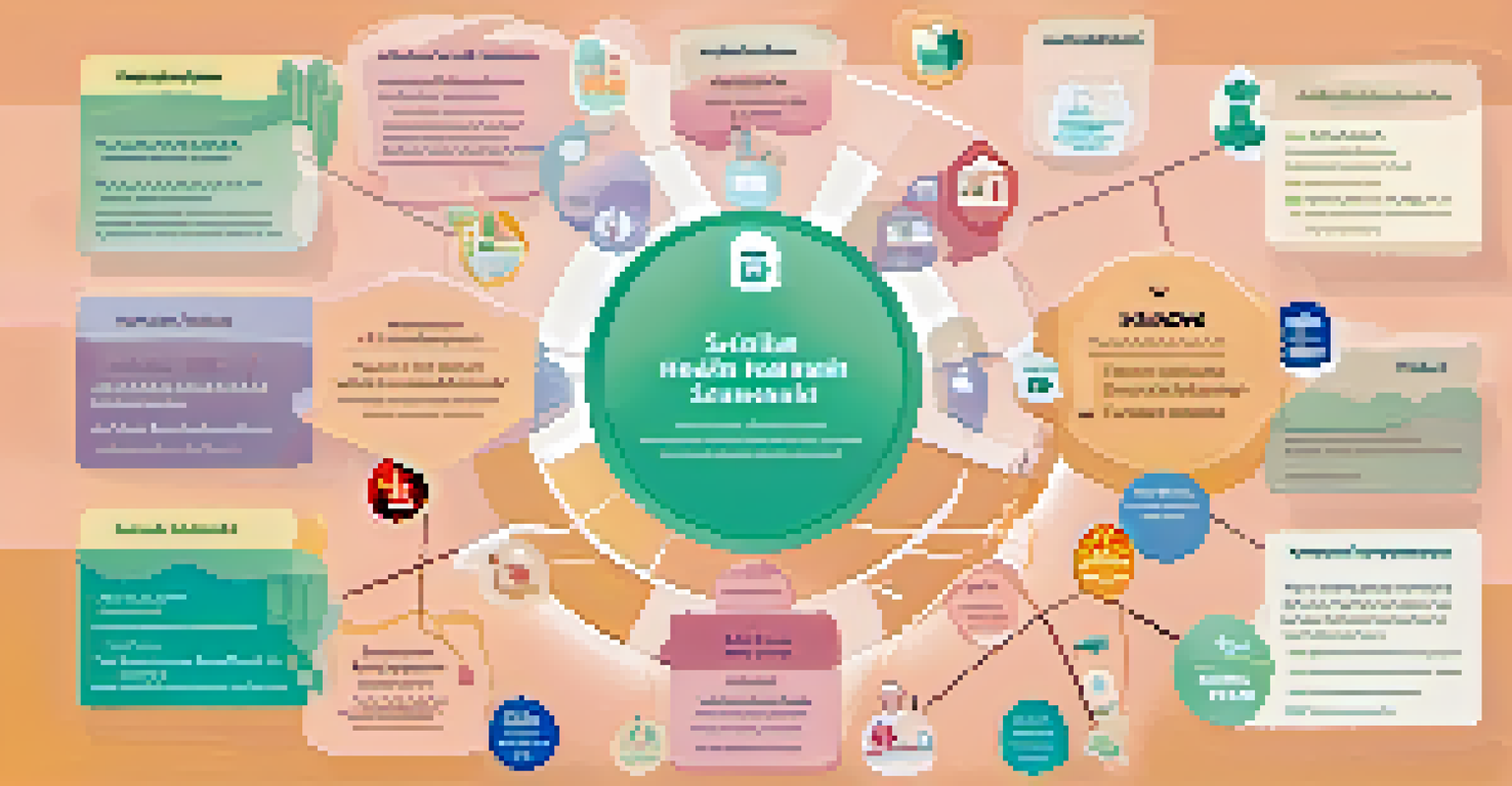Measuring Disease Incidence: Techniques and Challenges

Understanding Disease Incidence and Its Importance
Disease incidence refers to the number of new cases of a disease in a specific population during a given time period. It's crucial for public health officials to understand this metric, as it helps gauge the severity of an outbreak and allocate resources effectively. For example, tracking the incidence of flu cases can guide vaccination efforts and inform healthcare providers.
The greatest weapon against stress is our ability to choose one thought over another.
Measuring disease incidence provides insights into how diseases spread and affect different demographics. This understanding allows for targeted interventions, ultimately improving health outcomes. By observing trends over time, researchers can identify emerging health threats and develop strategies to mitigate them.
Furthermore, accurate incidence data can influence policy decisions at various levels. For instance, if a particular disease shows rising incidence rates in a community, local governments might implement preventive measures or educational campaigns to curb the spread. Thus, understanding disease incidence is foundational for effective public health strategies.
Common Techniques for Measuring Disease Incidence
Several techniques exist for measuring disease incidence, with the most common being cohort studies and cross-sectional surveys. Cohort studies track a group of individuals over time to see who develops the disease, providing valuable incidence rates. On the other hand, cross-sectional surveys capture a snapshot of disease occurrences at a specific point in time.

Another technique is the use of health registries, where data about diagnosed cases are collected systematically. These registries can reveal patterns in incidence over time and geography, offering insights into potential risk factors. For example, a cancer registry might show higher incidence rates in certain areas, prompting further investigation into environmental factors.
Disease Incidence Guides Public Health
Understanding disease incidence is crucial for public health officials to allocate resources and implement effective interventions.
Additionally, mathematical models and statistical methods can help estimate incidence from available data when direct measurement is challenging. These methods allow researchers to predict trends and make informed projections about future disease occurrences, aiding public health planning.
Challenges in Accurately Measuring Disease Incidence
Despite the importance of measuring disease incidence, several challenges can impact accuracy. One major hurdle is underreporting, where not all cases are documented due to accessibility issues or stigma associated with certain diseases. For instance, diseases like HIV may see lower reported incidence rates because of fear of discrimination.
Health is not just the absence of disease. It is a state of complete physical, mental, and social well-being.
Another challenge is the variability in diagnostic criteria and reporting practices across different regions or healthcare systems. This inconsistency can lead to discrepancies in data, making it difficult to compare incidence rates globally. For example, one country might have strict criteria for diagnosing a disease while another uses a broader definition.
Lastly, changing population dynamics, such as migration and aging, complicate the measurement of disease incidence. As populations shift, new at-risk groups may emerge, and existing data may no longer reflect the current situation. Public health officials must continually adapt their measurement techniques to account for these evolving demographics.
The Role of Technology in Disease Incidence Measurement
Technology has revolutionized the way disease incidence is measured and tracked. With the advent of electronic health records (EHRs), healthcare providers can easily document and share patient information, leading to more comprehensive data collection. For instance, real-time tracking of infectious diseases during an outbreak can facilitate quicker responses from health authorities.
Moreover, mobile health applications and wearable devices are becoming valuable tools in monitoring health trends. These technologies can gather data on symptoms and risk factors from users, providing researchers with a wealth of information. Imagine a scenario where a flu tracking app alerts users about rising cases in their area, prompting them to get vaccinated.
Tech Enhances Disease Tracking
Advancements in technology, such as electronic health records and mobile health apps, significantly improve the measurement and tracking of disease incidence.
Additionally, advanced data analytics and machine learning techniques allow public health officials to analyze large datasets more effectively. This capability helps identify patterns and predict future disease incidence, leading to more proactive public health measures. As technology continues to evolve, it will undoubtedly enhance our understanding of disease dynamics.
Integrating Social Determinants in Disease Incidence Studies
Social determinants of health, such as socioeconomic status, education, and environment, play a significant role in disease incidence. To get a complete picture, researchers must consider these factors when measuring incidence rates. For example, areas with limited access to healthcare often report higher incidence rates for preventable diseases.
Incorporating social determinants can help identify at-risk populations and develop targeted interventions. For instance, if a particular community shows high diabetes incidence, understanding the underlying social factors—like access to healthy foods—can inform effective prevention strategies. This holistic approach ensures that public health initiatives address root causes rather than just symptoms.
Moreover, integrating social determinants into disease incidence studies can lead to more equitable health outcomes. By acknowledging and addressing the disparities in health access and outcomes, public health officials can create policies that promote health equity. This shift towards a more inclusive perspective is essential in tackling public health challenges.
The Importance of Timely Data Collection
Timely data collection is critical for measuring disease incidence accurately. In the face of an outbreak, rapid reporting can significantly influence the effectiveness of public health responses. For example, during the COVID-19 pandemic, timely data allowed governments to implement restrictions and vaccination campaigns based on real-time incidence rates.
However, collecting data quickly can pose challenges, especially in resource-limited settings. Health systems may struggle with inadequate infrastructure or personnel, leading to delays in reporting. To overcome this, innovative solutions like mobile reporting apps can streamline the process and ensure that data is collected and shared promptly.
Social Factors Impact Disease Rates
Incorporating social determinants of health is essential for accurately measuring disease incidence and developing targeted public health strategies.
Furthermore, ensuring that data collection methods are standardized can enhance the quality and reliability of the information gathered. By developing clear protocols, health organizations can reduce discrepancies and improve the overall understanding of disease incidence. Ultimately, timely and accurate data collection is vital for effective public health decision-making.
Future Directions in Measuring Disease Incidence
As we look to the future, measuring disease incidence will likely become increasingly sophisticated. Advances in technology and data collection methods will enhance the accuracy and timeliness of incidence measurements, enabling more effective public health interventions. For instance, the use of artificial intelligence could help analyze vast amounts of health data to identify trends and predict outbreaks.
Moreover, interdisciplinary collaboration will be essential in refining disease incidence measurement techniques. By bringing together epidemiologists, data scientists, and social scientists, researchers can develop comprehensive approaches that consider various factors influencing disease spread. This collaborative effort can lead to more effective policies and interventions.

Lastly, public engagement and education will play a vital role in the future of disease incidence measurement. Encouraging individuals to report symptoms and participate in health surveys can enrich the data landscape. As communities become more involved in public health efforts, the overall understanding of disease incidence will improve, leading to healthier populations.